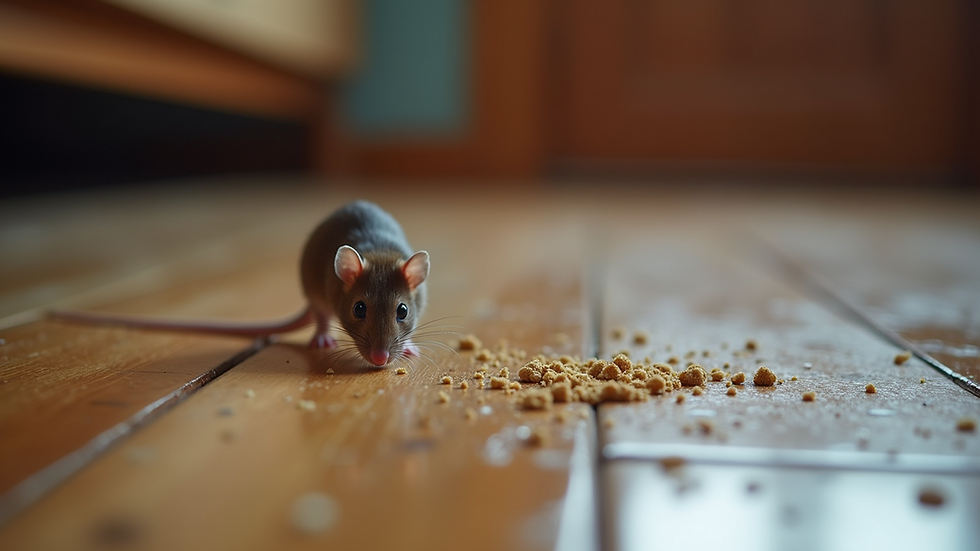How to Spot Signs of Rodent Infestation
- plymouth122
- 3 minutes ago
- 3 min read
Rodents can cause significant damage to homes and businesses if left unchecked. Detecting their presence early is crucial to prevent costly repairs and health risks. This guide will help you understand how to spot signs of rodent activity effectively. By learning what to look for, you can take swift action to protect your property.
Understanding How to Detect Rodent Presence
Rodents are clever creatures that often remain hidden. However, they leave behind clues that can reveal their presence. Knowing these clues is the first step in managing a potential infestation.
Droppings: One of the most obvious signs. Rodent droppings are small, dark, and pellet-shaped. They are often found near food sources, along walls, or in dark corners.
Gnaw marks: Rodents need to chew constantly to keep their teeth sharp. Look for gnaw marks on wood, plastic, wires, and food packaging.
Nests: Rodents build nests from shredded paper, fabric, or dried plant material. These are usually hidden in quiet, undisturbed areas.
Tracks and footprints: In dusty or muddy areas, you might spot small footprints or tail marks.
Sounds: Scratching or scurrying noises, especially at night, can indicate rodent activity.
By regularly inspecting your property for these signs, you can detect rodent presence early and take appropriate measures.

Key Areas to Inspect to Detect Rodent Presence
Rodents prefer certain locations where they can find food, water, and shelter. Focusing your inspection on these areas increases the chances of spotting an infestation early.
Kitchen and pantry: Food crumbs, spilled pet food, and accessible storage make these areas attractive.
Basements and crawl spaces: Dark, quiet, and often cluttered, these spaces provide ideal nesting spots.
Attics and roof spaces: Warm and secluded, these areas are perfect for rodents to breed.
Garages and sheds: Stored items and occasional food sources can attract rodents.
Walls and ceilings: Rodents often travel through wall cavities and ceiling voids, leaving behind gnaw marks or droppings.
Regularly checking these locations can help you spot early signs and prevent a full-blown infestation.

How to Identify Different Types of Rodents
Different rodent species leave different signs. Knowing which type you are dealing with can help tailor your control methods.
House mice: Small, about 7.5-10 cm long including the tail. Droppings are tiny, about 3-6 mm. They prefer grains and seeds.
Norway rats: Larger, 20-25 cm long. Droppings are bigger, about 12 mm. They often live in lower areas like basements.
Roof rats: Slimmer and agile, about 16-20 cm long. They prefer higher places like attics and roofs.
Each species has unique habits and preferred hiding spots. Identifying the species can improve the effectiveness of your rodent control strategy.
Practical Steps to Confirm Rodent Activity
Once you suspect rodents, it is important to confirm their presence before taking action. Here are some practical steps:
Set up monitoring stations: Use non-toxic tracking powder or flour in suspected areas to capture footprints.
Use bait stations: Place bait in secure stations to attract rodents and confirm activity.
Install motion-activated cameras: These can capture images or videos of rodents in action.
Check for fresh droppings: Fresh droppings are shiny and moist, while old ones are dry and crumbly.
Listen carefully: Quiet environments at night can reveal scratching or squeaking sounds.
Confirming rodent activity helps you decide on the urgency and type of control measures needed.
Preventive Measures to Avoid Rodent Infestation
Prevention is always better than cure. Taking proactive steps can keep rodents away from your property.
Seal entry points: Close gaps around doors, windows, pipes, and vents with steel wool or metal mesh.
Maintain cleanliness: Keep food sealed, clean up crumbs, and remove garbage regularly.
Reduce clutter: Clear out piles of paper, cardboard, and unused items that can serve as nesting material.
Fix leaks: Rodents need water, so repair dripping taps and pipes.
Trim vegetation: Keep shrubs and trees away from the building to reduce access points.
Implementing these measures reduces the risk of rodent infestation and protects your property.
When to Seek Professional Help
If you notice persistent signs or a large number of rodents, professional pest control services may be necessary. Experts can:
Conduct thorough inspections
Identify the rodent species
Use safe and effective control methods
Provide ongoing monitoring and prevention advice
Early intervention by professionals can save you time, money, and stress.
For more detailed information on signs of rodent infestation, visit the linked resource.
Detecting rodent presence early is key to protecting your home or business. By knowing what to look for and where to look, you can act quickly and effectively. Stay vigilant and maintain good hygiene to keep rodents at bay.




Comments